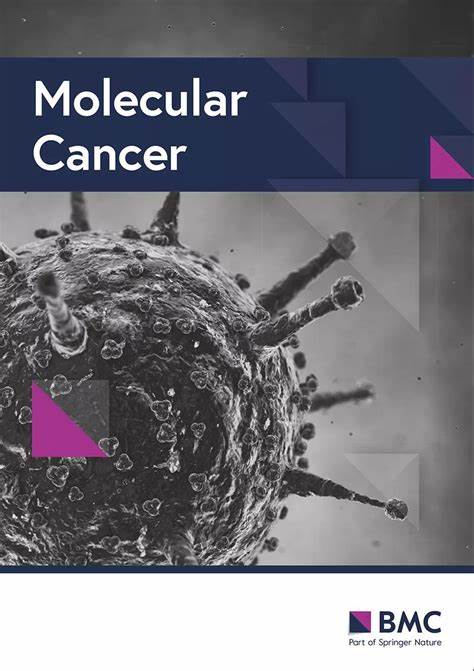Multi‑omics analysis identifies different molecular subtypes with unique outcomes in early-stage poorly differentiated lung adenocarcinoma
IF 33.9
1区 医学
Q1 BIOCHEMISTRY & MOLECULAR BIOLOGY
引用次数: 0
Abstract
Early-stage poorly differentiated lung adenocarcinoma (LUAD) is plagued by a high risk of postoperative recurrence, and its prognostic heterogeneity complicates treatment and surveillance planning. We conducted this integrative multi-omics study to identify those patients with a truly high risk of adverse outcomes. Whole-exome, RNA and whole methylome sequencing were carried out on 101 treatment-naïve early-stage poorly differentiated LUADs. Integrated analyses were conducted to disclose molecular characteristics and explore molecular subtyping. Functional validation of key molecules was carried out through in vitro and in vivo experiments. Recurrent tumors exhibited significantly higher ploidy (p = 0.024), the fraction of the genome altered (FGA, p = 0.042), and aneuploidy (p < 0.05) compared to non-recurrent tumors, as well as a higher frequency of CNVs. Additionally, recurrent tumors showed hypomethylation at both the global level and in CpG island regions. Integrative transcriptomic and methylation analyses identified three molecular subtypes (C1, C2, and C3), with the C1 subtype presenting the worst prognosis (p = 0.024). Although frequently mutated genes showed similar mutation frequencies across the three subtypes, the C1 subtype exhibited the highest tumor mutation burden (TMB), mutant-allele tumor heterogeneity (MATH), aneuploidy, and HLA loss of heterozygosity (HLA-LOH), along with relatively lower immune cell infiltration. Furthermore, GINS1 and CPT1C were found to promote LUAD progression, and their high expression correlated with a poor prognosis. This multi-omics study identified three integrative subtypes with distinct prognostic implications, paving the way for more precise management and postoperative monitoring of early-stage poorly differentiated LUAD.多组学分析发现早期低分化肺腺癌中不同分子亚型具有独特的结果
早期低分化肺腺癌(LUAD)术后复发风险高,其预后异质性使治疗和监测计划复杂化。我们进行了这项综合多组学研究,以确定那些真正具有高风险不良后果的患者。对101例treatment-naïve早期低分化luad进行了全外显子组、RNA和全甲基组测序。综合分析揭示分子特征,探索分子分型。通过体外和体内实验对关键分子进行功能验证。与非复发肿瘤相比,复发肿瘤表现出更高的倍性(p = 0.024)、基因组改变的比例(FGA, p = 0.042)和非整倍性(p < 0.05),以及更高的cnv频率。此外,复发肿瘤在全球水平和CpG岛区域均表现出低甲基化。综合转录组学和甲基化分析鉴定出三种分子亚型(C1、C2和C3),其中C1亚型预后最差(p = 0.024)。尽管频繁突变的基因在三种亚型中表现出相似的突变频率,但C1亚型表现出最高的肿瘤突变负担(TMB)、突变等位基因肿瘤异质性(MATH)、非整倍性和HLA杂合性缺失(HLA- loh),以及相对较低的免疫细胞浸润。此外,GINS1和CPT1C可促进LUAD的进展,其高表达与预后不良相关。这项多组学研究确定了三种具有不同预后意义的整合亚型,为早期低分化LUAD的更精确管理和术后监测铺平了道路。
本文章由计算机程序翻译,如有差异,请以英文原文为准。
求助全文
约1分钟内获得全文
求助全文
来源期刊

Molecular Cancer
医学-生化与分子生物学
CiteScore
54.90
自引率
2.70%
发文量
224
审稿时长
2 months
期刊介绍:
Molecular Cancer is a platform that encourages the exchange of ideas and discoveries in the field of cancer research, particularly focusing on the molecular aspects. Our goal is to facilitate discussions and provide insights into various areas of cancer and related biomedical science. We welcome articles from basic, translational, and clinical research that contribute to the advancement of understanding, prevention, diagnosis, and treatment of cancer.
The scope of topics covered in Molecular Cancer is diverse and inclusive. These include, but are not limited to, cell and tumor biology, angiogenesis, utilizing animal models, understanding metastasis, exploring cancer antigens and the immune response, investigating cellular signaling and molecular biology, examining epidemiology, genetic and molecular profiling of cancer, identifying molecular targets, studying cancer stem cells, exploring DNA damage and repair mechanisms, analyzing cell cycle regulation, investigating apoptosis, exploring molecular virology, and evaluating vaccine and antibody-based cancer therapies.
Molecular Cancer serves as an important platform for sharing exciting discoveries in cancer-related research. It offers an unparalleled opportunity to communicate information to both specialists and the general public. The online presence of Molecular Cancer enables immediate publication of accepted articles and facilitates the presentation of large datasets and supplementary information. This ensures that new research is efficiently and rapidly disseminated to the scientific community.
 求助内容:
求助内容: 应助结果提醒方式:
应助结果提醒方式:


